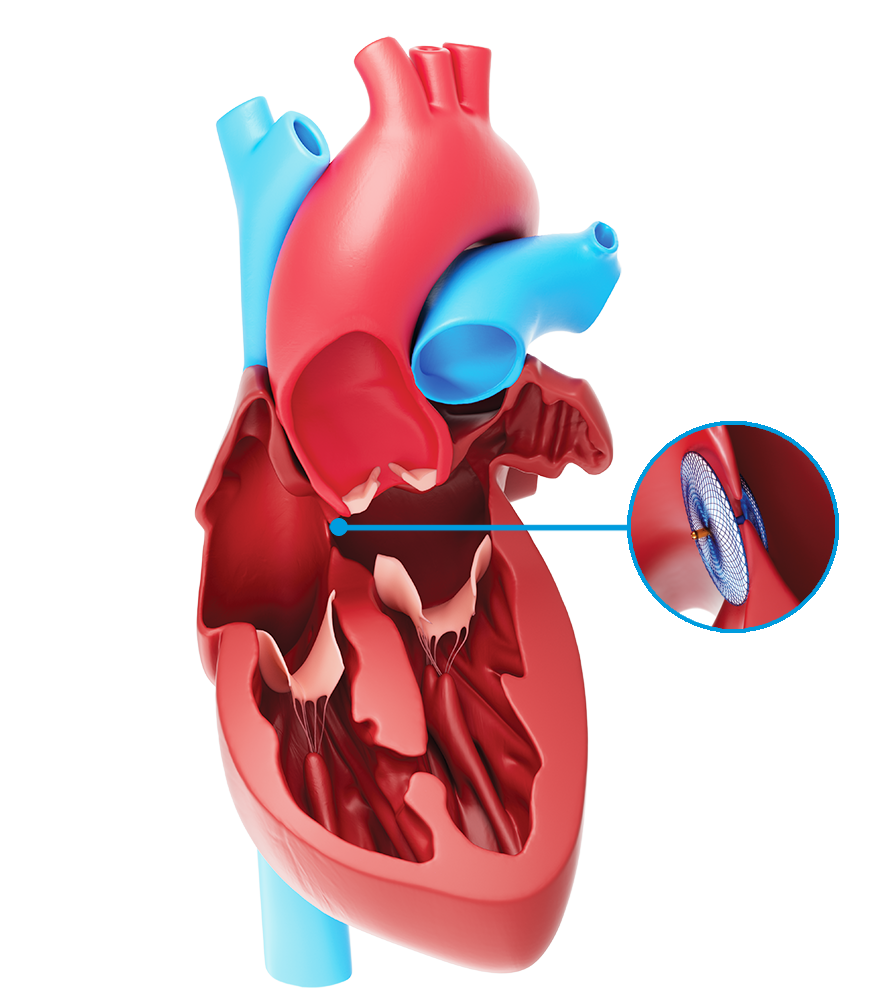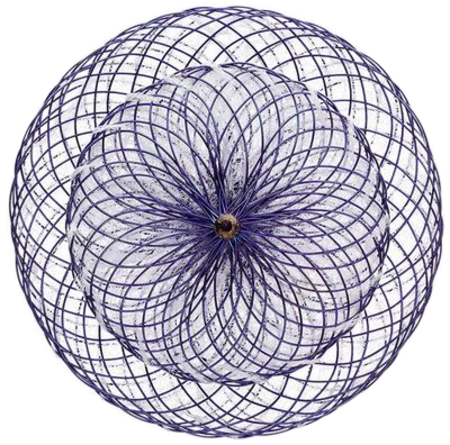PFO Closure
PFO TREATMENT OPTIONS
If you have had a stroke of unknown cause and have also been diagnosed with a patent foramen ovale (PFO) you may have had a PFO-associated stroke. For people with a PFO-associated stroke, PFO closure with the Amplatzer™ Talisman™ PFO Occluder is a treatment option to reduce the risk of another stroke.

Discuss all treatment options with your doctor
Your doctor can describe the risks and benefits and help you decide which option is right for you.

BLOOD-THINNING
MEDICATION
Your doctor may prescribe blood-thinning medication to reduce your chance of having blood clots. Aspirin (taken daily) is the recommended medication for most patients to reduce the risk of having another ischemic stroke. Some physicians recommend stronger blood-thinning medications called anticoagulants.

OPEN HEART SURGERY TO CLOSE THE PFO
Today, open heart surgery is rarely performed to close a PFO unless it is performed together with another surgery or the heart team determines that device closure with an occluder is not technically possible.1,2

PFO CLOSURE
A PFO occluder is a device that can be placed in your heart close to the PFO through a minimally-invasive, catheter-based technique, and is designed to stop blood flow through the PFO.
Understanding PFO closure and the Amplatzer™ Talisman™ PFO occluder
Download the PFO treatment guide to learn more about the treatment options.

Reducing the risk of another stroke with
the Amplatzer™ Talisman™ PFO occluder
The fear of having another stroke can be overwhelming. With the Amplatzer Talisman PFO Occluder, your doctor may be able to significantly reduce the risk of stroke recurrence. Researched extensively in clinical trials, the Amplatzer Talisman PFO Occluder has shown up to a 97% relative risk reduction for recurrent ischemic stroke when compared to medical management therapy.3
With a proven track record of more than 180,000 devices implanted globally over 25 years,4 the Amplatzer Talisman PFO Occluder is relied upon by thousands of physicians around the world.
The Amplatzer Talisman PFO Occluder is a device specifically designed to stop blood flow through a PFO, reducing your risk of a recurring ischemic stroke. The device consists of two circular wire-mesh discs covered in a medical fabric that sandwich together to close the PFO between the two upper chambers in your heart (the left atrium and right atrium).
The wire mesh material can be collapsed down to fit a small tube (catheter) which is used to position the device during the procedure. Once the device is placed in the PFO, it will remain permanently implanted in your heart. Over time, the body’s natural healing process will cover the device with tissue.

FIND A DOCTOR NEAR ME
Frequently asked questions
about PFO closure
- How do I know which treatment option is right for me?
Before implantation of the Amplatzer Talisman PFO Occluder, other potential causes for your past stroke should be ruled out by your neurologist and cardiologist. If no cause is identified for your stroke (that is, you have had a stroke of unknown cause) and you have been determined to have a PFO, this team of doctors may recommend the Amplatzer Talisman PFO Occluder for you.
Before undergoing PFO closure, your doctors will also evaluate specific factors that need to be considered for the implantation procedure itself including:
- Your overall medical status
- Suitability of your vessels and heart size and shape for the catheter-based procedure
- Your suitability for general or local anesthesia
- Your suitability to have ultrasound imaging of the heart
- Your suitability for radiation exposure during the procedure that is necessary to implant the Amplatzer Talisman PFO Occluder
- What do you need to do before the PFO closure procedure?
Be sure to talk with your doctor about any medication you may be taking. He/she might advise you to adjust your medications prior to the procedure. Your doctor may tell you not to eat or drink anything after midnight prior to the procedure. You should plan on making arrangements for a ride to and from the hospital, and arrange for help at home (if necessary) after the procedure.
- What happens during the PFO closure procedure?
The PFO closure procedure will take place in a heart catheterization laboratory, where minimally invasive procedures are performed. Before beginning the procedure, you will receive a sedating medication to help you relax and local anesthetic so that you do not feel any significant discomfort. The catheter-based procedure involves making a very small skin incision (cut), typically in the right groin area, and inserting a small tube (called a catheter) to guide the Amplatzer Talisman PFO Occluder through the blood vessels to close the PFO within your heart.
Once the device is placed across the PFO, the cardiologist will carefully study its position using cardiac imaging tools. When the cardiologist is satisfied with the position of the Amplatzer Talisman PFO Occluder, the device will be released to remain permanently in the heart, all catheters will be removed and the implant procedure is complete. The procedure should last between one and two hours.
- What happens after the PFO closure procedure?
After the procedure, your medical team will discuss an after-care plan with you, and you should expect to be discharged from the hospital within 24 hours. Before you are discharged from the hospital, you will receive a patient identification card. You will be prescribed aspirin (81 to 325 mg) and clopidogrel (75 mg) to be taken daily for one month after the implant procedure, followed by daily aspirin (81 to 325 mg) alone for at least five additional months. Your doctor may prescribe additional medication (typically aspirin daily) beyond six months. You will have an echocardiogram at six months so that your doctor can make sure that your device is properly implanted and to assess the closure of the PFO.
Regular check-ups with your doctor are very important. Call or see your doctor whenever you have questions or concerns about your health. If you have any unusual problems such as bleeding, pain, other discomfort or changes in your overall health, be sure to contact your doctor.
Always carry your Amplatzer Talisman PFO Occluder implant card and tell other doctors that you have a PFO closure device before any medical, dental or MRI (magnetic resonance imaging) procedures. Failure to do so may result in health problems or damage to the device.
- What risks are associated with the PFO closure procedure?
As with any medical procedure, there is a possibility of complications. The most serious risks of the procedure include:
- Blood clot in the heart, leg or lung requiring long-term anticoagulation therapy
- Blood or fluid build-up between the heart muscle and the sac that covers the heart requiring a drainage procedure
- Death
- Irregular and/or rapid heart rate (particularly atrial fibrillation)
- Perforation of the heart muscle or vessels
- Stroke (major or minor)
Additional potential risks associated with the procedure or the device include:- Allergic reaction to anesthesia
- Allergic reaction to contrast dye used to visualize heart during the implant procedure
- Allergic reaction to a drug used during the procedure
- Allergic metal reaction: Nitinol (nickel, titanium), platinum/iridium, stainless steel (chromium, iron, manganese, molybdenum, nickel)
- Arrhythmia (loss of regular heart rhythm)
- Bleeding
- Blood clot on device
- Blood vessel blockage due to blood clots or air
- Chest pain
- Fever
- Fluid buildup around lungs
- Headache or migraine
- Heart attack
- Heart valve damage that interferes with valve closure
- High or low blood pressure
- Incomplete closure of PFO
- Infection
- Injury to the heart or vessels
- Injury to the nerves in the arm or lower neck
- Movement of the device from its position within the PFO or to other parts of the body
- Sudden interruption of blood flow to an organ or body part
- Surgery or intervention to remove the device
- Trouble or inability to breathe
WARNINGS- If you are prone to venous blood clots, your doctor may prescribe a blood thinning medication (usually an anticoagulant) for at least 6 months.
- Talk to your doctor if you are allergic to nickel. The Amplatzer Talisman PFO Occluder is made of a metal called nitinol containing nickel and titanium.
PRECAUTIONSTalk to your doctor if you are:
- Pregnant
- Have a history of multi-organ failure
- Unable to take blood thinning medication
- Who should not have the procedure?
The Amplatzer Talisman PFO Occluder should not be implanted in patients who:
- Have a tumor or blood clots at the implantation site of the device or in the vessels through which the device is advanced to reach the heart
- Have blood vessels too small to allow the delivery system to pass through
- Have an anatomy in which the device would interfere with heart or vascular function
- Have other types of heart defect
- Have infection of the heart
The information provided is not intended for medical diagnosis or treatment or as a substitute for professional advice. Consult with a physician or qualified healthcare provider for appropriate medical advice.
MAT-2305650 v5.0 | Item approved for U.S. use only.
